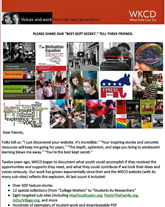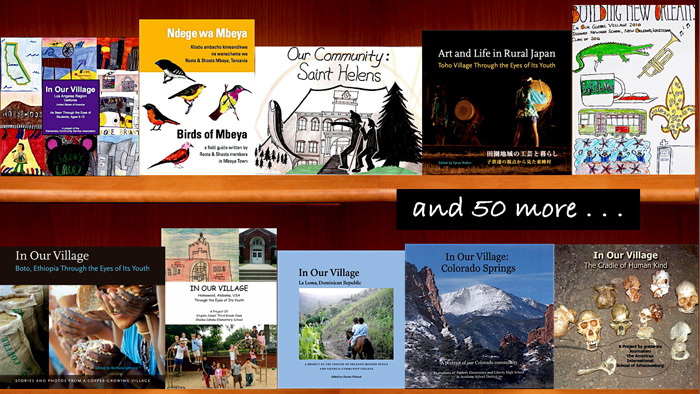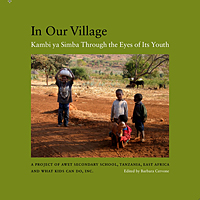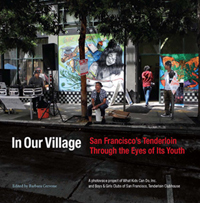OTHER WKCD WEBSITES SPECIAL COLLECTIONS Students as Allies in School POPULAR WKCD PUBLICATIONS (PDFS] A Guide to Creating Teen- Cultural Conversations through Creative Writing Documenting Immigration Stories First Ask, Then Listen: How Your Students Can Help You Teach Them Better Making Writing Essential to Profiles of Politically Active Youth Queer Youth Advice for Educators The Schools We Need: Creating Small High Schools That Work for Us
| In Our Global Village: Youth Documenting Their Communities NOTES FROM THE FIELD by Barbara Cervone | NOVEMBER 2015
FOUR YEARS AFTER HURRICAN KATRINA, sixth-graders in a New Orleans classroom gather to list what makes their city unique. A world away, at a community school in the jungles of Nepal, youth of all ages share pictures of their families and homes, in the first two chapters of a book they are creating. What happens when young people are invited to tell their community’s stories? A lot, I’ve learned. In the past decade, What Kids Can Do (WKCD) and its publishing arm, Next Generation Press, have helped youth across the globe capture daily life in the places they live. With support from teachers and other adults, these young people generate photos or drawings and gather stories about the “village” they call home. The In Our Global Village series now includes over 60 such books, from youth on five continents. A virtual library, curated by WKCD, gives a worldwide audience to their images and words. Where soil covers our feet The program began ten years ago, when my son, at 22, was working in a remote village in Tanzania. There—as I learned on my own overwhelming first visit—life depends on the bounty of each year’s harvest. At the village’s secondary school, I invited youth to take on the role of photojournalist and tell their village’s story. They would provide the creative talent. I would provide the editing. And whatever money the book earned would go back to the village.
Six months later, a dozen students and I were walking the 40 kilometers of dirt trails that crisscross Kambi ya Simba. Using digital cameras and voice recorders for the first time, they gathered photographs and interviews about everything from maize porridge and livestock to the bare-bones village infirmary. These students didn’t believe—they told me when we parted—that anyone outside their village would care about their story and their lives, “where soil covers our feet.” They were wrong. In Our Village: Kambi ya Simba Through the Eyes of Its Youth has sold more than 10,000 copies, inspiring scores more projects like this one. Profits from those sales have helped two dozen Kambi ya Simba students attend postsecondary schools far beyond their village. All twelve of the book’s authors have completed teaching or university degrees, the first in their families to go past primary school. “Writing this book made me want to touch the sky,” Pius, now 26, said when our group reunited last summer in Tanzania. Tender and not Albert, an earnest 18-year-old who was born in Vietnam, likes to photograph his San Francisco neighborhood at night, because he likes the sharpened focus that comes with black and white. He lives in the city’s Tenderloin district, long home to the city’s homeless and mentally ill, but now pulsing with new immigrants drawn by cheap rents.
I met Albert in May 2014 at the Tenderloin Clubhouse of the Boys & Girls Clubs of San Francisco. I had come to write a story about this oasis for youth in the neighborhood, all of them first- and second-generation immigrants. The club’s art director took me aside. He was eager to show me the photographs his students had taken, as part of an afterschool neighborhood photovoice project. A homeless man hugging his dog. A discarded syringe. Families and children lined up at a soup kitchen. These subjects drew his young photographers—and turned heads at the resulting exhibit, “Ain’t Nothin’ Tender,” at a San Francisco gallery. The Club art director and I quickly cooked up a plan. Working together, with a corps of the Club’s teen leaders and younger students, we would use the photographs as a starting point to create a “Tenderloin book” for the Global Village series. Our young collaborators agreed that we would show both the tender and the rough aspects of their “village.” They worked out their chapters and stories: about growing up in one of the world’s most diverse communities, about sizing up danger in a neighborhood where violent crime rules. They wrote about favorite foods, learning to swing a baseball bat, squeezing a family of five into two small rooms. In Our Village: San Francisco’s Tenderloin Through the Eyes of Its Youth made its debut in August 2015. Once again, the book’s young authors are turning heads in venues across their city. WKCD provides guidelines and a sample curriculum to others coaching students to contribute to our In Our Global Village series. In its burgeoning collection of publications, one sees powerful evidence of what happens when young people learn to tell their community’s stories:
What Kids Can Do, Inc. | info@whatkidscando.org | www.whatkidscando.org
|





